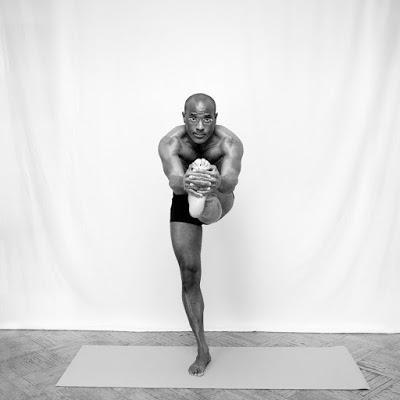
Vincent, Age 51, photographed by Sara Bennett
If you have been reading our blog during 2015 or following either our Yoga for Healthy Aging or my Baxter Bell Yoga Facebook pages, you know that since the beginning of the year, I have been introducing a new balance pose every week to my students in Oakland and around the country. (You can find videos of all my balance poses of the week on my YouTube channel Baxter Bell Yoga.)I was motivated to do this after reading studies that showed the benefit of improved balance on reducing the risks of falling (see The Importance of Preventing Falls), which can be a devastating turn of events for some. Some of new poses I made up were either closely or loosely aligned with existing yoga poses (for example, my Cypress pose was a variation of Vrksasana or Tree pose) and others were more of a stretch (Pirate’s pose 2.0, for instance!). And each week I was involved in the creative process of coming up with a new balance pose, no small feat for someone not accustomed to such endeavors. (Special thanks to those out there who shared with me their balance creations, such as 4 Corners, which took the pressure off for a week now and then). I personally discovered this process was both daunting and delightful, but more importantly I found my students were open to trying out my new inventions, even renaming them on occasion!Through my personal studies on balance, I rediscovered the complexity of balance, which integrates many levels of the mind, both conscious and reflexive, with input from skin, joints, muscles, fascia, eyes, and ears. And in looking into recent research on balance, I discovered that a variety of scientists—from gerontologists doing research on improving balance in their vulnerable patients to sports medicine academies looking to improve athletic performance and reduce sports injuries—were looking for new ways of improving balance. From these fields of study I found several core concepts that I began to integrate into my classes and teaching, such as that of challenging or stressing a person’s limits of stability (the area outside of his or her base of support he or she can go without losing control of the center of gravity) via “controlled instability” and “cognitive distracting drills” (see The Great Balance Pose of the Week and Adding Distraction to Your Balance Poses). I found the following guidelines particularly relevant for yoga practice:
- Moving from simple to complex (for example, doing Tree pose and Warrior 3 independently, then creating a dynamic sequence combining them (see Tree-to-3)
- Progressing from known to unknown (for example, practicing Tree pose and then introducing Cypress pose)
- Progressing from static to dynamic (for example, practicing static Eagle pose and then Dynamic Eagle pose)
- Progressing from stable to unstable (for example, Packin' the Trailer with a foot on the ground to standing on a block)
- Progressing from eyes open to eyes closed (applicable for classic yoga balance poses, such as Half Moon pose, or any of my new poses)
- Emphasizing quality over quantity (mindfulness comes into play here nicely

